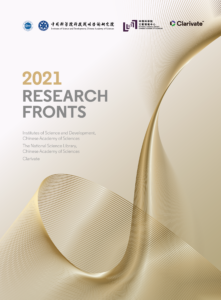To examine fast-moving, emerging areas of science, Clarivate and the Chinese Academy of Sciences partnered to identify dynamic areas of research. Read more.
Research Fronts 2021, marks the eighth collaboration between the two organizations. The 2021 report, like its predecessor, bases its findings on Research Fronts, which are self-organizing clusters of related research identified by citation analysis.
Research Fronts form when clusters of highly cited papers are frequently cited together. This pattern of “co-citation,” as it’s known, indicates that the papers share a cognitive link or point of commonality, such as a concept or hypothesis, experimental data or method. With the co-cited papers serving as a foundational ‘core,’ the other element in the Research Front consists of the subsequent papers that cite the core.
An organic perspective
 A unique advantage of Research Fronts is that identifying these ‘nodes’ of specialized activity does not depend on the judgements of human indexers or analysts. Rather, researchers themselves define these fronts, when they select the most pertinent and significant work to cite. In this way, Research Fronts provide a more organic perspective on how specialty areas form, grow, branch out, merge with other disciplines, and, possibly, dissipate, as new citation-based groupings come to the fore.
A unique advantage of Research Fronts is that identifying these ‘nodes’ of specialized activity does not depend on the judgements of human indexers or analysts. Rather, researchers themselves define these fronts, when they select the most pertinent and significant work to cite. In this way, Research Fronts provide a more organic perspective on how specialty areas form, grow, branch out, merge with other disciplines, and, possibly, dissipate, as new citation-based groupings come to the fore.
This dynamic view of the research landscape is invaluable in providing knowledge and foresight to policymakers and administrators in governmental, academic, and commercial settings, and to anyone with an interest in the latest areas of concentration and activity in science.
As in past reports, analysts from Institute of Strategic Information within the Institute of Science and Development, and the National Science Library of the Chinese Academy of Sciences, collaborated with bibliometric experts from Clarivate, turning to the Essential Science Indicators database, which is built on the foundation of the Web of Science™ index.
Analysts first consolidated 20 of the 22 subject fields in Essential Science Indicators into 11 broad specialty areas. Starting with 12,147 Research Fronts, representing papers published and cited between 2015 and 2020, the next step was to select the fronts containing core literature that is both highly cited and recent – a measure of particularly active and fast-moving research.
Ultimately, the analysis produced 110 fronts that are especially active, or “hot,” as well as 61 emerging fronts, with the latter selected on the basis of notably recent core literature. Based on the research themes, contents and characteristics of the selected Research Fronts, information professionals at the Chinese Academy of Sciences renamed each of the 171 Research Fronts.
In addition to listing all 171 Research Fronts across the 11 specialty areas, the report’s discipline-based chapters include detailed examinations of selected fronts, including rankings of notable nations and institutions whose contributions are central to each front’s core and citing literature.
A broad range
As in previous reports, the latest compendium of fast-moving Research Fronts reflects a broad range of specialty areas and topics. Most strikingly, the 2021 edition conveys the rapid and pervasive impact of COVID-19 on global research.
The report documents the worldwide surge of research on the SARS-CoV-2 coronavirus and its clinical course. However, the pertinent Research Fronts are not confined to biological and medical subfields. In the social sciences, for example, investigation has focused on the mental-health aspects of the pandemic. Even ecological factors have drawn attention, in studies of how air pollution has affected the severity of outbreaks in COVID hotspots.
In geosciences, meanwhile, a hot Research Front examines another pressing issue: the recent global increase in extreme precipitation events. The development of accurate and comprehensive datasets for tracking and gauging precipitation has been crucial to understanding episodes of catastrophic rainfall. At the other extreme, the study of wildfire emissions also constitutes an area of intensive investigation.
Other Research Fronts consist of ongoing research across the scientific spectrum. In chemistry, for example, “chromodynamic therapy” involves the harnessing of a chemical reaction in the human body to kill cancer cells while causing little harm to normal tissue. In biology, researchers are advancing a gene-modification method known as base editing, which improves on the accuracy of the CRISPR/Cas method. Meanwhile, astronomers and astrophysicists are exploring the possibility that primordial black holes are a constituent the of the dark matter that makes up a substantial portion of mass in the universe.
These examples, of course, represent only a small sampling of the 171 specialty areas specified in the report.
Fields and nations
Released concurrently with Research Fronts 2021 is the updated version of another yearly report: “Research Fronts 2021: Active Fields and Leading Countries.” This report provides a deeper view of Research Front activity, including extensive and nuanced metrics on national and institutional performance in the 2021 fronts.





